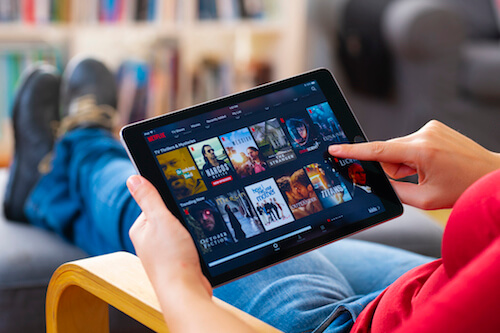You might feel like you’re spending too much—are you?
Are Streaming Subscriptions Worth It, or Should You Return to Cable?
Are your streaming subscriptions worth the money?
With the move from cable to streaming, lots of people wonder, “Are we actually saving anything?”
Let’s find out.
- : How much are you spending on streaming vs. cable?
- : As if the streaming subscriptions themselves weren’t enough …
- : Yes, they do exist!
- : Netflix isn’t our top recommendation. Surprised?
The average cost of streaming versus cable TV
If you used to be a cable person but converted to streaming, you might wonder if you’re actually saving any money with streamable, on-demand content versus cable.
In August 2021, research firm J. D. Power reported that the average American household spends $55 each month on four to five streaming services. The top services include Netflix, Amazon Prime Video, Hulu, Disney+, Paramount+, and Max.¹
Most cable TV services start at around $50 a month. At that price, you get around 100 to 400 channels (it varies wildly based on the service), and both Verizon Fios TV and Optimum Cable TV give you over 400 channels for just a tad above $50, if not less.
Typically, you’ll see more niche content, news, and sports with cable, but you won’t see as much quality original TV or newer blockbuster movies. That’s streaming’s arena.
With that data in hand, the value of steaming versus cable seems pretty subjective. If you like the type of content found on your streaming services, spending $55 on your favorite subs is worth it. But if you’re more into what cable’s offering, then you might as well cut out $5 a month and switch back.
Hidden costs of streaming services
What about extra streaming costs?
For most people, streaming is more of a one-and-done. They sign up for the service and that’s all. But other folks may find themselves cracking open their wallets to improve their streaming experience.
Devices
Want an Apple TV? An Amazon Fire Stick? A Roku Streambar? All those things can improve your streaming experience—and all of them cost money.
An Apple TV isn’t as expensive as some HD or 4K TVs, but buying one still costs more than streaming on the TV you already have. That’s $190 you could spend on something else. (To learn more, check out How Much Does an Apple TV Cost?)
Meanwhile, the latest Amazon Fire Stick costs $39.99. Yes, that’s right—easy remote access to all your streaming apps costs as much as a whole month of the apps themselves. And a Roku Streambar (a “streaming media player and premium audio”) costs a minimum of $99.
And these aren’t the only devices you might buy to improve your streaming experience. Quality speakers, faster routers, plasma screens—the sky’s the limit. As long as your budget can keep up, that is.
Data limits and internet speed
If your stream keeps stuttering, that may be a sign that you’ve maxed out your phone or internet data limit and need to get an upgraded plan. And yes, upgraded plans tend to cost more than what you already have.
Exact plan details and costs depend on your chosen phone or internet provider. Here’s what we recommend for phone data and home internet speeds.
Commercial-free
If sitting through commercials gets your goat, you’ve probably gone commercial-free, and as your wallet knows, commercial-free costs more.
How much more? Well, Hulu with no ads is $7 more per month, and Max with no ads is $6. That’s not a mind-boggling price jump, but upgrading either service does increase your streaming costs by about 10%. Upgrading both is a 20%ish increase.
Service switching
With most services, if you buy a year at once, you save some money. But a lot of folks don’t buy in advance—they jump back and forth between services every month based on what’s hot and fresh.
In some cases, you’re saving money by only watching the content you want, when you want. But with services you keep going back to, you’re missing out on the long-term savings of 12-month discounts.
How to save on streaming services
If you’re planning to keep your streaming services but want to save some money, here are a few tips.
Pay up front
With services you know you’ll want long-term, we recommend paying for a year at a time.
For instance, if your small children live off Doc McStuffins, you’ll save around $15 when you pay for a year of Disney+ up front.
Not every service offers year-long plans, but many do. We recommend taking advantage wherever it will save you money. (Hint: it won’t save you money with a service you use one month every year, but it will with a service you continually use for months at a time.)
Use streaming freebies
Sometimes, when you buy something else, you get streaming perks.
Buy a new iPhone? Sweet, now you have three months of Apple TV+.
Switch to T-Mobile? Enjoy your free Netflix account!
Get Amazon Prime for free shipping? Don’t forget to check out Amazon Prime Video.
And that’s not all. American Express and Chase offer cash back and other rewards with a bunch of different streaming services. AT&T, Verizon, and T-Mobile offer Max, Prime Video, and Disney+ streaming accounts, respectively. And you can get a limited free Disney+ subscription with Amazon Music Unlimited or the Xbox Game Pass Ultimate.
We’re not saying you should buy any of these things because you get freebies. That kind of defeats the purpose! But it’s nice to know that if you make any of these purchases, you’ll also save a little on streaming.
Look for deals
Like everything else, streaming subscriptions go on sale from time to time. Most of the sales happen around Black Friday, but we recommend checking in with your favorite services around major holidays, just in case. You never know when you’ll snag a sweet deal!
The only downside? You can’t take advantage of a sale for a service you’re already signed up for.
And we can help you stay updated with current internet and strreaming deals.
Try free content
Almost every streaming device has some apps with free content. Yes, that’s right—free as in you don’t have to pay for it.
Tons of apps stream previously made content, original content, or even both at no cost. Some of our favorites include the following:
- Pluto TV
- YouTube
- YouTube Kids
- Dust
- Peacock
- Tubi
- Amazon Freevee
- Haystack News
- Plex
- Crackle
- FilmRise
- PBS/PBS Kids
- Roku Channel
- Fire TV News
Not all setups have the same apps, though, so the content and content quality will depend on what device you’re using.
To learn more, check out our videos about free Chromecast apps, free Apple TV apps, and free Amazon Fire TV apps.
Recommended streaming services
Our top recommended streaming services probably aren’t what you expect! We recommend Fubo, YouTube TV, Netflix, Hulu, and Sling over anything else. (Yes, even the house of mouse’s streaming service.)
We chose our top five streaming services based on value, content, and price. For a deeper dive into why each one made the list, check out Best Streaming Services.
Recap
So are your streaming subscriptions worth it? We say yes—you’re probably spending about as much on streaming as you would on cable.
Could they be more worth it? Also yes, especially if you find yourself spending a lot on the hidden costs of streaming.
If your streaming is too expensive, can you fix the problem? Easily. It’s not hard to find ways to save money on streaming to get an even better value out of your dollar.
Related Articles



